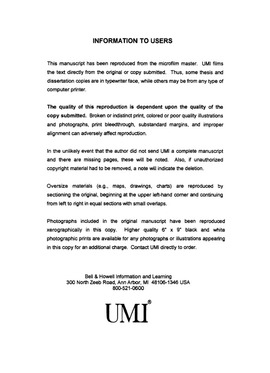| dc.contributor.advisor | Magrath, Jane, | en_US |
| dc.contributor.author | Davis, Peter Lowell. | en_US |
| dc.date.accessioned | 2013-08-16T12:31:12Z | |
| dc.date.available | 2013-08-16T12:31:12Z | |
| dc.date.issued | 2001 | en_US |
| dc.identifier.uri | https://hdl.handle.net/11244/6060 | |
| dc.description.abstract | This study provided a descriptive analysis of test scores for dynamic (loudness) accuracy of pianists who practiced three pieces with various types of non-interactive musical instrument digital interface (MIDI) accompaniment. Participants were 39 university non-keyboard music majors in second semester piano classes and were divided into three treatment groups. One group practiced with subtle dynamic contrast/complex MIDI orchestration accompaniment, the second with exaggerated dynamic contrast/complex MIDI orchestration accompaniment, the third with exaggerated dynamic contrast/simple MIDI orchestration accompaniment, and a control group practiced with no accompaniment. | en_US |
| dc.description.abstract | Participants in the accompaniment groups improved in dynamic accuracy slightly more on average than participants in the control group. Dynamic accuracy, however, was inconsistent both within groups and in many participants' individual scores from posttest to posttest. On average, the exaggerated dynamic contrast/simple MIDI orchestration accompaniment group gained slightly more in dynamic accuracy than other accompaniment groups. Group means for dynamic accuracy of all three treatment groups were slightly higher for the posttest played with accompaniment than for the same piece without accompaniment. | en_US |
| dc.description.abstract | A sight-reading pretest measured participants' initial dynamic accuracy ability. Next each treatment group with its respective type of accompaniment practiced the pieces for two weeks in class. Participants then recorded posttests, playing without MIDI accompaniment. One piece was also posttested with accompaniment. A panel evaluated these recordings for dynamic accuracy. A Likert-type survey investigated participants' attitudes and perceptions about practicing with MIDI accompaniment. | en_US |
| dc.description.abstract | Most participants agreed (47%) or strongly agreed (41%) that they enjoyed playing with the accompaniments. Most also agreed (38%) or strongly agreed (40%) that the accompaniments helped their dynamic accuracy. A significant, positive correlation emerged between gain in dynamic accuracy and a positive attitude toward practicing with MIDI accompaniments. | en_US |
| dc.description.abstract | Although teachers may want to select materials with MIDI accompaniments---especially accompaniments with exaggerated dynamic contrast, simpler orchestrations, and authentic-sounding instrumentation---teachers should not view MIDI accompaniments as an automatic means to improvement in dynamic accuracy. Students' improvement may depend also on attitude, notational difficulty, and tonal control. Students may also need to be trained to retain the effects of an accompaniment when no longer playing with it. | en_US |
| dc.format.extent | xi, 204 leaves : | en_US |
| dc.subject | Music Instruction and study. | en_US |
| dc.subject | Music Interpretation (Phrasing, dynamics, etc.) | en_US |
| dc.subject | Education, Music. | en_US |
| dc.subject | Education, Higher. | en_US |
| dc.title | A descriptive analysis of dynamic (loudness) accuracy test scores for college non-keyboard music majors in group piano classes who practiced with four types of MIDI accompaniment. | en_US |
| dc.type | Thesis | en_US |
| dc.thesis.degree | Ph.D. | en_US |
| dc.thesis.degreeDiscipline | School of Music | en_US |
| dc.note | Source: Dissertation Abstracts International, Volume: 61-11, Section: A, page: 4319. | en_US |
| dc.note | Major Professor: Jane Magrath. | en_US |
| ou.identifier | (UMI)AAI9994074 | en_US |
| ou.group | Weitzenhoffer Family College of Fine Arts::School of Music | |
